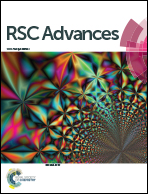Ultrahigh capacitance of amorphous nickel phosphate for asymmetric supercapacitor applications
Abstract
This article presents the effect of different calcination temperatures on the structural, morphological and capacitance of nickel phosphate (Ni3(PO4)2) as an electrode material for supercapacitor applications. Ni3(PO4)2 was synthesized via a sonochemical method followed by calcination at different temperatures (300, 600 and 900 °C, denoted as N300, N600 and N900, respectively). The phase structure and purity of Ni3(PO4)2 were confirmed by X-ray diffraction (XRD) and Fourier transform infrared (FTIR) analysis. The surface morphologies showed that the particle size increased with increasing the calcination temperatures. The electrochemical performance of N300, N600 and N900 were investigated using cyclic voltammetry (CV) and galvanostatic charge–discharge (GCD) in a 1 M KOH electrolyte. It was found that N300 exhibited the maximum specific capacity of 620 C g−1 at 0.4 A g−1, which was significantly higher than N600 (46 C g−1) and N900 (14 C g−1). Here, the enhanced electrochemical performance was obtained due to the amorphous structure and augmentation of the redox active sites of the N300 particles. Additionally, the fabricated N300//activated carbon based asymmetric supercapacitor can be cycled reversibly at a cell voltage of 1.45 V. The device exhibited an energy density of 76 W h kg−1 and a power density of 599 W kg−1 with life cycles of 88.5% capacitance retention after 3000 cycles.


 Please wait while we load your content...
Please wait while we load your content...